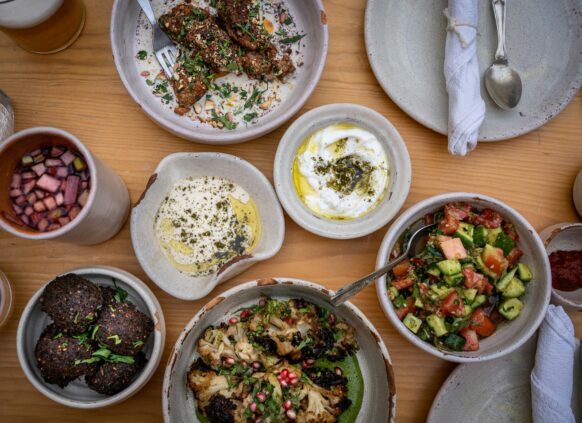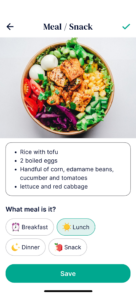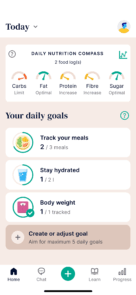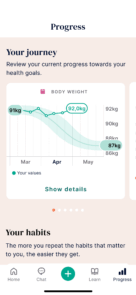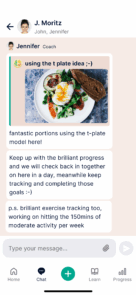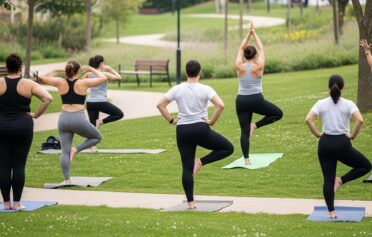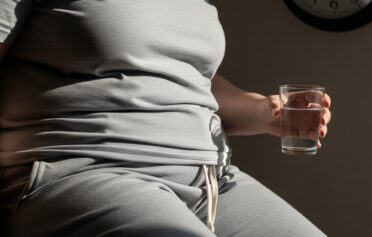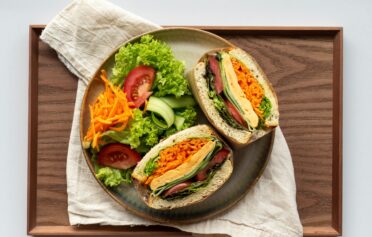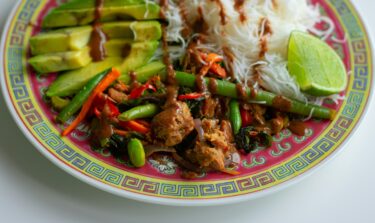
Top 12 foods to lower cholesterol (and how to eat them)
Cholesterol plays an important role in your body, but too much of it can increase your risk of heart problems. Over time, high cholesterol can build up in your blood vessels and lead to heart disease or stroke.
The good news is that small changes to what you eat can help lower your cholesterol. Including certain foods in your meals, and avoiding the foods that can increase cholesterol, can support your heart health.
If you have a BMI over 35, you might be eligible for tailored support through a programme like Oviva.
Key Takeaways
- Oats, beans, lentils, aubergines, avocados, fatty fish and fibre-rich fruits may help lower cholesterol.
- Sustainable changes to what you eat can reduce LDL (or ‘bad’) cholesterol over time.
- Losing weight can also support heart health, and many of these foods can help.
- With the right support, programmes like Oviva can help you build long-term habits that improve cholesterol.
Can what you eat help lower cholesterol?
Yes – your food choices can play a big part in managing cholesterol.
While food alone might not always be enough, small, sustainable changes to your diet can make a real difference to your cholesterol levels and overall health.
Foods to eat
- Soluble fibre, found in oats, pulses, apples, bananas and barley, can help reduce how much cholesterol is absorbed into your blood.
- Healthy fats, like omega-3 fatty acids, may help lower LDL (‘bad’) cholesterol, which can build up in your blood vessels.
- Plant-based foods are naturally high in fibre and contain no cholesterol, making them a heart-friendly option.
Read more: Does fasting lower cholesterol?
Professional support
If you’re eligible for Oviva’s weight management programme, you’ll get access to tailored support from dietitians and other healthcare experts to help build healthy eating habits that work for you.
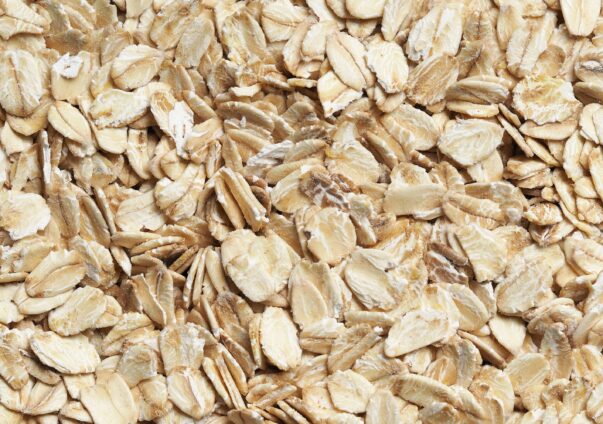
Top 12 cholesterol-lowering foods
Looking to lower your cholesterol through food? These 12 everyday options can form the foundation of a heart-friendly eating plan.
1. Oats and barley
Oats and barley contain beta-glucan, a type of soluble fibre that helps reduce LDL cholesterol. Soluble fibre also limits how much cholesterol is absorbed in the gut.
To lower cholesterol, aim for 3 g of beta-glucan per day – about two to three servings.
Breakfast cereals and oatcakes are great sources.
How to add oats and barley to a low-cholesterol diet:
- Eat porridge with fruit for breakfast
- Use oatcakes or barley in soups, risottos or stews
2. Beans, lentils and pulses
Beans, lentils, and pulses like chickpeas are high in soluble fibre and provide plant-based protein, making them a great choice for vegetarians and vegans.
Replacing red meat with beans or pulses can help lower saturated fat intake, which matters because too much saturated fat can raise LDL or ‘bad’ cholesterol.
These foods may also help lower cholesterol by binding to bile acids in your digestive system.
How to add beans, lentils and pulses to a low-cholesterol diet:
- Add chickpeas to a salad
- Make a lentil soup
- Choose low-sugar and low-salt baked beans and wholegrain bread for beans on toast
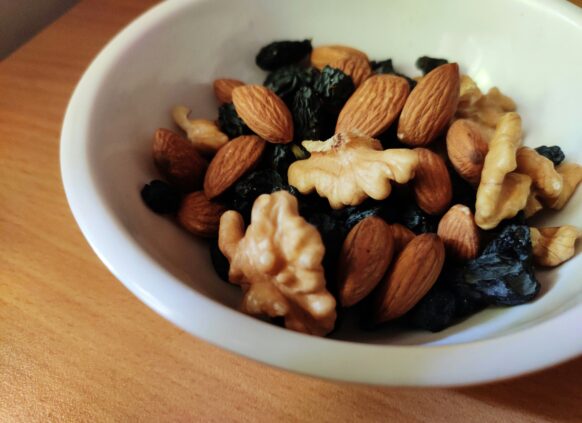
3. Nuts (especially almonds and walnuts)
Nuts are rich in healthy fats and can help reduce inflammation and support heart health.
Research shows that almonds, walnuts and hazelnuts can lead to small to moderate reductions in LDL cholesterol levels.
Choose unsalted varieties – almonds and walnuts are especially beneficial as they’re high in omega-6 fats too.
How to add nuts to a low-cholesterol diet:
- Snack on a small handful of unsalted nuts
- Sprinkle chopped nuts onto porridge or yoghurt
- Add cashews to a stir-fry
4. Fatty fish (such as salmon, mackerel, and sardines)
Fatty fish are high in polyunsaturated fats, which can help lower LDL or ‘bad’ cholesterol.
Omega-3 fatty acids in fish reduce triglycerides – this matters because triglycerides can build up in the arteries, raising the risk of heart issues when combined with high cholesterol.
Salmon, mackerel, and sardines can also replace saturated fat sources, like red meat, and may increase HDL or ‘good’ cholesterol.
How to add fish to a low-cholesterol diet:
- Grill or bake salmon for lunch or dinner
- Add canned mackerel to wholegrain toast or a salad
- Add tinned sardines to a tomato pasta sauce
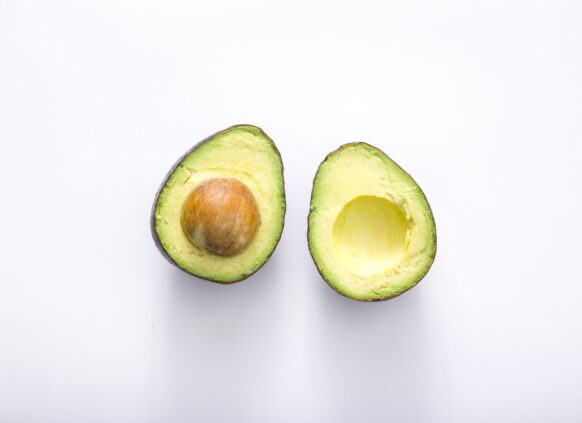
5. Avocados
In a study that looked at the impact of different foods on cholesterol, avocados were one of the most effective for lowering cholesterol.
They’re rich in monounsaturated fats, which help maintain HDL or ‘good’ cholesterol while lowering LDL or ‘bad’ cholesterol.
Avocados may also improve your lipid profile and help you feel fuller for longer.
How to add avocados to a low-cholesterol diet:
- Smash and spread on wholegrain toast
- Add to a salad
- Use in a smoothie to provide a creamy texture
6. Fruits high in soluble fibre (including apples, pears and berries)
Fruits like apples, pears and berries contain pectin, a type of soluble fibre linked to lower cholesterol. They’re also naturally sweet, making them a helpful swap for sweets and processed snacks in a low-cholesterol diet.
As an added benefit, these fruits are high in antioxidants.
How to add fruit to a low-cholesterol diet:
- Snack on an apple
- Add berries to your porridge
- Make a fruit smoothie
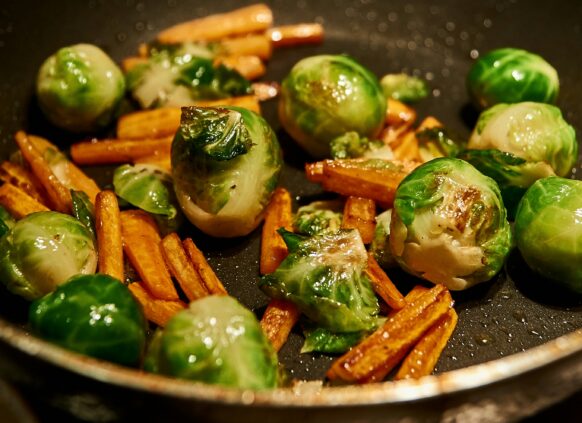
7. Vegetables (especially aubergine, okra, carrots, and brussels sprouts)
Vegetables like aubergine, okra, carrots and Brussels sprouts are rich in soluble fibre and low in calories. This means they can help reduce LDL cholesterol and support weight loss.
They’re also nutrient-dense and can help keep you feeling full for longer.
How to add vegetables to a low-cholesterol diet:
- Roast vegetables and serve as a side dish
- Stir into soups, stews or curries
8. Plant sterol- or stanol-enriched foods (like fortified spreads, milks)
Sterols and stanols can block cholesterol absorption in the gut. Up to 3 g per day has the potential to lower LDL cholesterol by more than 10%.
Look for foods fortified with plant sterols or stanols, such as spreads, milks and yoghurt drinks. They work best when eaten with a main meal.
They’re generally safe for almost everyone, but not suitable for pregnant women.
How to add plant sterols and stanols to a low-cholesterol diet:
- Use fortified spread on wholemeal bread or toast
- Look out for sterol-fortified yoghurt drinks
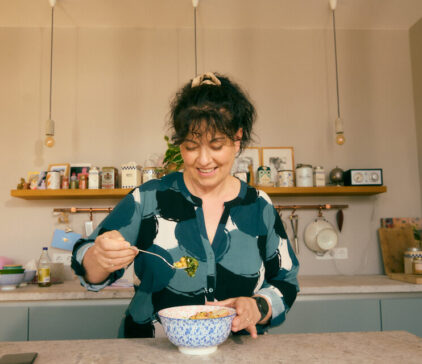
What I love about Oviva is that I can eat what I want — it was a completely new experience for me not to count calories. I lost 5 kg in the first 12 weeks, and my blood pressure normalised.
9. Extra virgin olive oil
Extra virgin olive oil is a source of monounsaturated fat. This helps to maintain HDL cholesterol, which can remove harmful forms of cholesterol from your bloodstream.
It’s also linked to an improved LDL-HDL cholesterol ratio and has anti-inflammatory and antioxidant properties that may help protect against oxidative stress.
How to add olive oil to a low-cholesterol diet:
- Use for roasting vegetables
- Add to salad or a salad dressing
- Drizzle on soups or use to sauté green vegetable
10. Whole grains (such as brown rice, wholemeal bread, and quinoa)
Whole grains are a good source of fibre and resistant starch, which support digestion, fullness and blood sugar control – all of which can help with both cholesterol and weight management.
Resistant starch helps feed healthy gut bacteria and may support lower LDL cholesterol and improved insulin sensitivity.
How to add whole grains to a low-cholesterol diet:
- Swap white rice, bread and pasta for brown versions
- Use quinoa or bulgur as a base for salads or grain bowls
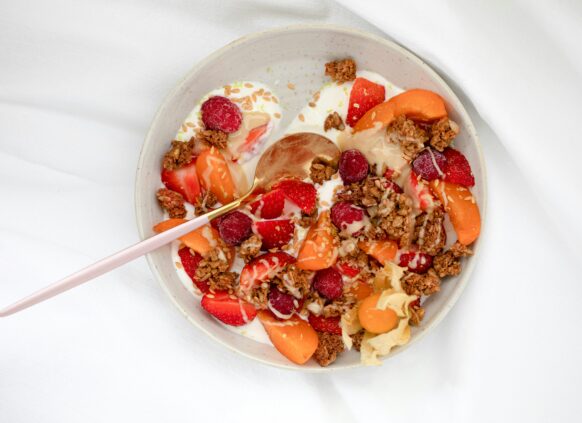
11. Flaxseeds
Flaxseeds are rich in soluble fibre and omega 3, and have been shown in studies to reduce LDL cholesterol. Flaxseeds are also anti-inflammatory and prebiotic – they feed the good bacteria in your gut. Ground flaxseed is typically better absorbed than whole seeds.
How to add flaxseeds to a low-cholesterol diet:
- Add a tablespoon to salad, yoghurt or porridge
- Add to smoothies
12. Soy products (including tofu, soy milk, edamame, and soy yoghurt)
Soy products are a plant-based protein and may modestly lower LDL cholesterol.
They can be a great replacement for red meat which is higher in saturated fat. For example, you can use soy mince as a substitute for minced beef.
How to add soy products to a low-cholesterol diet:
- Add edamame to salads
- Use soy milk in tea, coffee and smoothies
- Add tofu to curries or a stir-fry
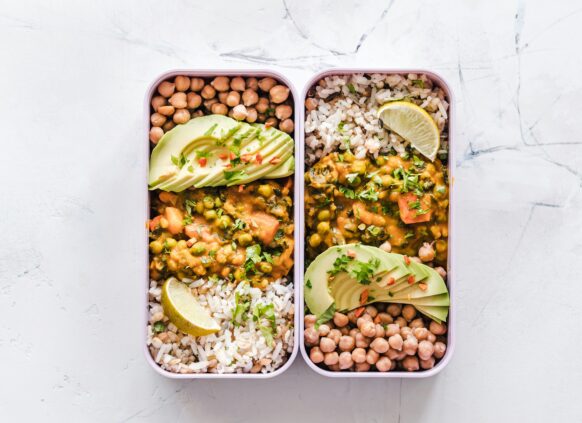
How to make a cholesterol-lowering diet
These simple tips can help you make the switch to a cholesterol-lowering diet:
1. Focus on fibre, unsaturated fats and colourful plant-based meals
Stir-fries and salads are a great way to boost fibre. A helpful guide for your evening meal is to fill half your plate with vegetables. This not only adds fibre but also supports portion control without needing to count calories.
2. Cut down on saturated fats from processed foods and red meat
To lower cholesterol, reduce processed foods and red meat. Try switching to fatty fish, skinless poultry or tofu instead. Whenever you can, cook from scratch using whole foods rather than relying on ready meals.
3. Avoid trans fats – check food labels
Trans fats are found in some meat and dairy products and can raise cholesterol levels.
Avoid products with partially hydrogenated vegetable oil too – choose extra virgin olive oil as a healthier alternative.
4. Swap fried foods for grilled, steamed, or roasted options
Fried foods are often high in saturated and trans fats. Try alternatives like grilled, roasted or steamed options instead.
5. Keep added sugar and salt to a minimum
Where you can, reduce your salt and sugar intake, and avoid added salt and sugar whenever possible.
Try to prepare meals from scratch as much as is realistic for you, and make simple changes like switching from salted to unsalted nuts.

One-day cholesterol-lowering meal plan
The meal plan below is a helpful example of how to lower cholesterol with simple, home-prepared meals – no strict diet or calorie counting needed.
Focus on nutritious, balanced meals that follow the key principles: limit saturated fats and include a variety of cholesterol-lowering foods.
| Meal | What to eat to lower your cholesterol |
| Breakfast | Porridge with soy milk, berries, and a sprinkle of flaxseeds |
| Morning snack | An apple with a small handful of almonds |
| Lunch | Lentil veggie soup with wholemeal toast and fortified spread |
| Afternoon snack | Soy yoghurt with chopped walnuts and pear slices |
| Dinner | Grilled salmon with brown rice, roasted aubergine and sprouts |
Frequently Asked Questions (FAQs)
Try filling more of your plate with vegetables
This can lower the amount of carbohydrates on your plate and gently reduce overall calories – no need to count them.
Healthy fats and plant-based proteins
Foods like nuts, seeds, tofu or olive oil can help with appetite and are a great swap for red meat, which is often higher in calories and saturated fat.
Even small changes can make a difference
Losing just 5 to 10% of your body weight can help lower LDL cholesterol and support heart health.
It doesn’t happen overnight
Changes may take a few weeks to show. If you’d like help staying on track, Oviva is here to support you.
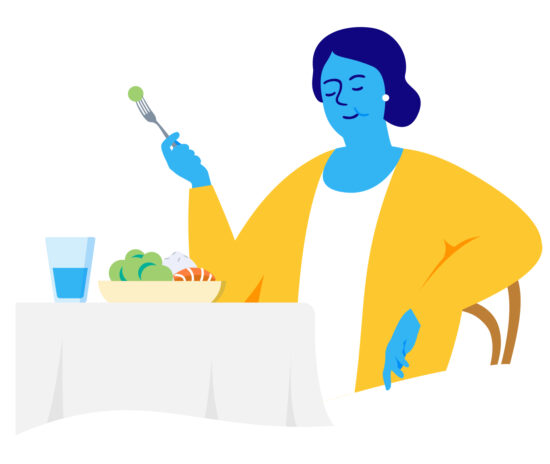
Ready to improve your health and feel more in control?
If you have a BMI over 35 and live with high cholesterol or another weight-related health condition, you may be eligible to join Oviva’s remote weight loss plan that’s fully funded by the NHS.
What makes Oviva different:
- A flexible, remote programme that fits around your lifestyle – no calorie counting, no intense gym routines
- Support from a team of experts, including dietitians, psychologists and doctors, who guide you every step of the way
- Tools to build lasting habits, with simple, science-backed techniques that work in real life
- A personalised care plan, adapted to your health needs and goals
- Prescription weight loss medication, when appropriate, to help kickstart progress
- The Oviva app, where you can log meals, track progress, access learning content and chat with your coach
This isn’t about cutting calories quick fixes. It’s about learning what works for you, and being supported to make changes you can stick with.
